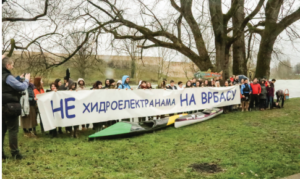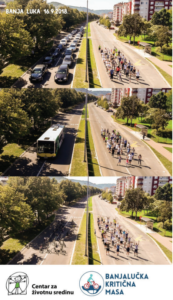Nikola Kurija is an environmental activist from Bosnia and Herzegovina. He is an activist group coordinator of the NGO “Center for Environment”, based in Banja Luka. His
activism started since when he was very young, participating in students’ organizations that dealt with different issues, while in parallel, and up to this day,in movements for the protection
of the environment. The scope of his organization is national, and it cooperates with other leading environmental organization of the country.
Today I’m going to present the organisation I work in, the Center for Environment.
Before that, just some basic information about Bosnia and Herzegovina. As you certainly know, it’s a former Yugoslav country, and after the war in the 90’s, we now have a pretty complicated territorial organisation and political system. Of course, I’m not going to bother you with politics, but this part is important to mention because of the government structure as it makes our job a lot more difficult.
Our organisation, the Center for Environment, or as we say, Centar za životnu sredinu, is the largest environmental NGO in the country. We have three main programmes: biodiversity and protected areas, energy and climate change, and transport. Apart from that, we had various campaigns that are not strictly tied to one of these programmes, but had a topic still very important for us, like our Anti GMO campaign, or our waste management campaign.
We are the Friends of the Earth member in the front of Bosnia and Herzegovina and are members of various local as well as international networks.
There is the Arhuus Center in Sarajevo, which provides legal advice to environmental NGO’s who don’t have their own legal representatives. The ecological and humanitarian organisation Gotuša fights mostly for river protection but also human rights, Eko Akcija from Sarajevo works on environmental topics in general, similar to us, Atelier for Society Change connects the environmental impact to human rights, also very active in river protection. Arbor Magna is an organisation that contains mostly experts in the field of forestry, biology and similar.
Even though we act throughout the whole country, it is important to emphasise that we cannot successfully fight for environment conservation in other parts of Bosnia without local involvement. Wherever we go, we try to find local citizens that are ready to speak out. That’s why we have so many networks of formal, but also non formal organisations with whom we are in constant communication.

 The Center for Environment was
The Center for Environment was
founded by a student’s organisation on the Faculty of Natural Sciences and mathematics back in 1999. At the time they were called ‘’Young researchers of Banja Luka’’. They noticed that they have minimum field work and practical work in their studies, so the goal of the organisation was to improve that.
However, after a few years they recognised the need for environmental activism, and so changed the name to the one we have today.
Among the first actions they had was saving Christmas trees. In December 2001 they would rent potted Christmas trees to citizens for a sum of 10 euros, and after the winter holidays, people would return the trees and get their money back, while the organisation took those trees out of town for replanting. When those activities ended, they dressed up as Christmas trees, while one of them was impersonating a lumberjack, and chased the trees through the city centre with a huge fake axe made of cardboard. The trees had messages on the costumes saying ‘’save our forests’’ or ‘’I want to live’’ and similar.
That was a lighthearted, not so serious action, but very quickly came a larger struggle.
In 2005 our government announced that they will build a hydropower plant on the river Vrbas. The initial project first initiated in the 60’s, but the Yugoslav government cancelled the construction because of a devastating earthquake that hit Banja Luka in 1969. They concluded that our region is very seismically active, and if an earthquake like that would damage the dam so close to the town, it would flood the whole town and the casualties would be enormous. The 2005 Republika Srpska government didn’t heed those warnings from the past and wanted to recycle the project. That’s why we founded the Coalition for Vrbas with various other organisations and gathered 17.000 signatures and had a huge protest. After public pressure the government gave up and the river was protected. They tried again in 2017, but we fought back and won again.
[Fig. 2 Nikola]
From 2013 to 2015 we had a large campaign called ‘’The Battle of Sutjeska’’. The national park Sutjeska is the largest and oldest national park in Bosnia and Herzegovina. It contains the last primeval forest of Europe, Perućica, various endemic and protected species, for example the Balkan chamois (Rupicabra rupicabra balcania).
The national park was threatened by private investors who planned to build small hydropower plants inside the territory, on the rivers Sutjeska and Hrčavka. The impact from construction of those dams would be devastating for the biodiversity of the national park, so we organised the first citizens initiative in Bosnia and Herzegovina and gathered 6000 signatures in 12 locations. We took the matter to court, won, and the projects were cancelled.
When you have been active for over 20 years, it is inevitable to face some lost battles. One of those is Bardača.
The Bardača wetlands are located at the northern part of Bosnia and Herzegovina, where the river Vrbas meets the Sava. It was protected in the 60’s by the Yugoslav government and became a Ramsar site because of the number of migratory birds that nested there. Unfortunately, it was damaged during the war, later dried out by an agricultural company and turned into ploughing fields. The government of Republika Srpska didn’t see the need to renew the previous protection from the former country. There were even a couple of trees over a hundred years old that were uprooted in order to turn the area into farmland.
The government denied our requests to protect the region again, and now its fortune lies in the hands of the company. Even today, if you google the wetlands, it says that it’s a complex of 11 lakes, even though it has only three left. We haven’t given up, every year on February the 2nd we organise a wetlands exhibition, promoting what’s left of the once beautiful area.
As I have mentioned before, we have three programmes. The campaigns I have spoken about up until now are from the biodiversity and energy programmes. Now we are coming up to transport and urban mobility.
Many Balkan cities are facing the same problem – old infrastructure aimed mostly at cars, bad public transport and non-existent bicycle infrastructure. That leads to citizens using cars for transportation inside the cities, even for small distances, which leads to pollution, traffic jams, occupied public space.
Apart from not having cycle lanes, we used to have bad cycling laws. Up until 2017, it was obligatory for cyclists to wear helmets and high visibility vests while riding. That demotivated people even further to cycle through town. That’s why we campaigned to change those laws and improve cyclist safety. On the picture you can see an experiment we did to show how much space 40 people take in cars, on a bus, on bikes and on foot.
[Fig 1 Nikola]
Every day you can see this on your roads, streets full of cars that have only one person inside. So, you get one person taking up 5-6 metres of road. Our activist group often goes out on the street during rush hour, from 7 do 8:30 in the morning, as well as from 3:30 do 5 p.m. Then we count and graph the number of cars with one person inside, two, three and etc., and compare the numbers.
An important part to any type of activism is to be up to date with information, being aware of what is going on around us. People often show their displeasure when it’s too late, when an area is already fenced in and work has already begun. In those situations, we usually can’t do much. That’s why it is important to follow up on news on government official websites. They are legally obliged to organise a public presentation, for example, when they want to change the urban plan of the city. There is a legal timeframe during which you can submit your comments, show up and speak out at the meeting. After a project is declared valid by the city assembly, it’s is difficult to change it back without going to court, and that makes the situation a lot more complicated and time consuming.




